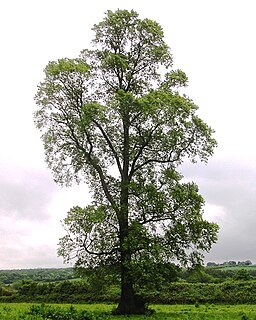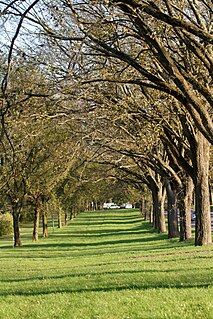Related Research Articles

Elms are deciduous and semi-deciduous trees comprising the flowering plant genus Ulmus in the plant family Ulmaceae. The genus first appeared in the Miocene geological period about 20 million years ago, originating in what is now central Asia. These trees flourished and spread over most of the Northern Hemisphere, inhabiting the temperate and tropical-montane regions of North America and Eurasia, presently ranging southward in the Middle East to Lebanon, and Israel, and across the Equator in the Far East into Indonesia.

Ulmus americana, generally known as the American elm or, less commonly, as the white elm or water elm, is a species of elm native to eastern North America, naturally occurring from Nova Scotia west to Alberta and Montana, and south to Florida and central Texas. The American elm is an extremely hardy tree that can withstand winter temperatures as low as −42 °C. Trees in areas unaffected by Dutch elm disease (DED) can live for several hundred years. A prime example of the species was the Sauble Elm, which grew beside the banks of the Sauble River in Ontario, Canada, to a height of 43 m (140 ft), with a d.b.h of 196 cm (6.43 ft) before succumbing to DED; when it was felled in 1968, a tree-ring count established that it had germinated in 1701.

Dutch elm disease (DED) is caused by a member of the sac fungi (Ascomycota) affecting elm trees, and is spread by elm bark beetles. Although believed to be originally native to Asia, the disease was accidentally introduced into America and Europe, where it has devastated native populations of elms that did not have resistance to the disease. It has also reached New Zealand. The name "Dutch elm disease" refers to its identification in 1921 and later in the Netherlands by Dutch phytopathologists Bea Schwarz and Christine Buisman, who both worked with Professor Johanna Westerdijk. The disease affects species in the genera Ulmus and Zelkova; therefore it is not specific to the Dutch elm hybrid.

Ulmus 'Nanguen' is a complex fourth generation Dutch hybrid cultivar raised at the Dorschkamp Research Institute for Forestry & Landscape Planning, Wageningen. Lutèce was derived from the cross 'Plantyn' ×, an ancestry comprising four field elms, a wych elm, the curious Exeter Elm ('Exoniensis'), and a frost-resistant selection of the Himalayan elm.

Ulmus 'New Horizon' is an American hybrid cultivar raised by the Wisconsin Alumni Research Foundation (WARF), from a crossing of the Japanese Elm clone W43-8 = 'Reseda' with Siberian Elm clone W426 grown from seed collected from a street tree at Yankton, South Dakota. Tested in the US National Elm Trial coordinated by Colorado State University, 'New Horizon' averaged a survival rate of 74% after 10 years.'New Horizon' was patented in the US in 1994, while in Europe, it is marketed as one of the 'Resista' elms protected under E U breeders' rights.

Ulmus 'Regal' is an American hybrid elm cultivar developed by the University of Wisconsin–Madison and released in 1983. 'Regal' was derived from seeds arising from the crossing of the Dutch hybrid clones 'Commelin' and '215' sent in 1960 by Hans M. Heybroek of the Dorschkamp Research Institute for Forestry & Landscape Planning, Wageningen, Netherlands.

The American Elm cultivar Ulmus americana 'Princeton' was originally selected in 1922 by New Jersey nurseryman William Flemer of Princeton Nurseries for its aesthetic merit. 'Princeton' was later found to have a moderate resistance to Dutch elm disease (DED).
The American elm cultivar Ulmus americana 'Augustine' was originally selected in Bloomington, Illinois, in 1927.

The American Elm cultivar Ulmus americana 'Delaware' was originally selected from 35,000 seedlings inoculated with the Dutch elm disease fungus in USDA trials at Morristown, New Jersey.

The American Elm cultivar Ulmus americana 'Valley Forge' was raised by the Agricultural Research Service in Maryland. The tree was released to wholesale nurseries without patent restrictions by the U. S. National Arboretum in 1995 after proving to have a high resistance to Dutch elm disease. 'Valley Forge' proved only moderately successful in the US National Elm Trial, averaging a survival rate of 66.7% overall, owing largely to environmental factors rather than susceptibility to disease.

The American Elm cultivar Ulmus americana 'New Harmony' was raised by the Maryland Agricultural Research Service and released by the United States National Arboretum in 1995, along with 'Valley Forge'. 'New Harmony' proved the most successful U. americana cultivar in the US National Elm Trial, averaging a survival rate of 85.5% overall.

The American Elm cultivar Ulmus americana 'Jefferson' was cloned from a tree growing near a path in front of the Freer Gallery of Art, close to the Smithsonian Institution Building on the National Mall in Washington, D.C. The United States National Park Service, which had planted the tree during the 1930s, cloned it in 1993 after screening tests showed that it possessed an outstanding level of tolerance to Dutch elm disease (DED).
The American elm cultivar Ulmus americana 'American Liberty' is in fact a group of six genetically distinct cultivars under a single name, although they are superficially similar. The Liberty elm is reportedly suitable for street planting, being tolerant of de-icing salts and air pollution. However, examples included in 10-year trials at Atherton, California to evaluate replacements for Californian elms lost to disease did not perform well. The late Professor Eugene Smalley summarized 'American Liberty' as "not as resistant as the Asian hybrids, but it still has the look of a classic American Elm".
The Chinese Elm cultivar Ulmus parvifolia 'Geisha' is a dwarf variety.
The American Elm cultivar Ulmus americana 'Morden' was cloned from a selection made by the Dominion Experimental Farm, Morden, Manitoba, in 1939 on account of its ability to withstand severe ice storms without breakage.
The elm cultivar Ulmus 'Acutifolia' was first described by Masters in Hortus Duroverni 66. 1831, and later by Mottet in Nicholson & Mottet, Dictionnaire pratique d'horticulture et de jardinage 5: 383, 1898.

Ulmus 'Fiorente' is a hybrid cultivar elm derived from a crossing of the Siberian Elm Ulmus pumila clone 'S.10' from Lucca, Italy, with the Ulmus minor clone 'C.02' from Lungarno, Florence, by the Istituto per la Protezione delle Piante (IPP), part of the Italian National Research Council, in Florence. 'Fiorente' was patented in 2006, and released to commerce in 2012.
The hybrid elm cultivar Ulmus × hollandica 'Cinerea' was first listed by George Lindley in 1815, as Ulmus cinerea, the Ash-coloured Elm, and later by the André Leroy Nurseries, Angers, France, in 1856. It was distributed as Ulmus cinerea by the Baudriller nursery, Angers, and as Ulmus montana cinerea by Louis van Houtte of Ghent. A specimen in cultivation at Kew in 1964 was found to be U. × hollandica, but the tree at Wakehurst Place remains listed as U. glabra 'Cinerea'.

The 'dwarf' elm cultivar Ulmus 'Jacqueline Hillier' ('JH') is an elm of uncertain origin. It was cloned from a specimen found in a private garden in Selly Park, Birmingham, England, in 1966. The garden's owner told Hillier that it might have been introduced from outside the country by a relative. Hillier at first conjectured U. minor, as did Heybroek (2009). Identical-looking elm cultivars in Russia are labelled forms of Siberian Elm, Ulmus pumila, which is known to produce 'JH'-type long shoots. Melville considered 'JH' a hybrid cultivar from the 'Elegantissima' group of Ulmus × hollandica. Uncertainty about its parentage has led most nurserymen to list the tree simply as Ulmus 'Jacqueline Hillier'. 'JH' is not known to produce flowers and samarae, or root suckers.
The American Elm cultivar Ulmus americana 'Penn Treaty' was raised by the Plant Sciences Data Center of the American Horticultural Society. Plants under that name were propagated by the Morris Arboretum, Pennsylvania, Philadelphia, from grafts made in 1945 from a tree at Haverford College, itself a graft from the Shackamaxon Treaty Elm in what was later named Penn Treaty Park, Kensington, Pa.
References
- ↑ Townsend, A. M., Bentz, S. E., and Douglass L. W. (2005). Evaluation of 19 American Elm Clones for Tolerance to Dutch Elm Disease. Journal of Environmental Horticulture, March 2005, Horticultural Research Institute, Washington, D.C.